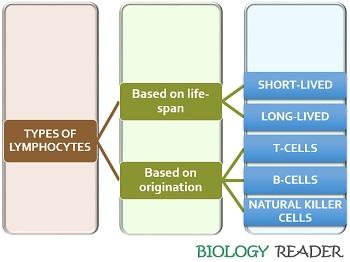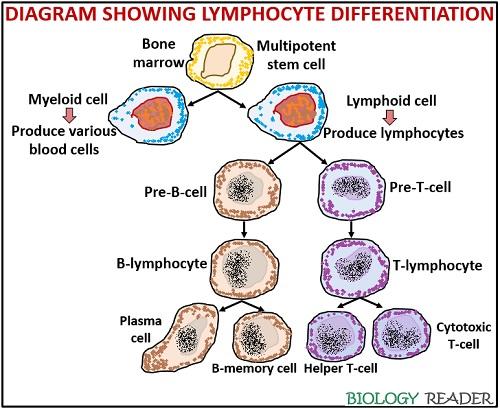Lymphocytes are the type of white blood cells, which belongs to the lymphoid lineage and differs from the other blood cells originate from the myeloid lineage. It is named, because of its dominance in the secondary lymphoid tissue “lymph”. Its normal range is about 20-40% of the total WBCs. Lymphocyte resides in an agranular, mononuclear cell group. The normal cell count of lymphocytes per µL of blood is about 800-5000 in adults and 3000-8000 in children.
Low lymphocyte count: It is a clinical condition refers as “Lymphocytopenia”, where the cell count decreases below 800 in adults and 3000 in children.
High lymphocyte count: It is a clinical condition refers as “Lymphocytosis”, where the cell count increases above 5000 in adults and 8000 in children.
Content: Lymphocytes
Meaning of Lymphocytes
Lymphocytes can define as one of the kinds of white blood cells that differentiate into three kinds, namely T, B and NK cells from the multipotent stem cell in the bone marrow and undergoes further processing and maturation. There are three significant kinds of lymphocytes, namely Thymus derived T-cell, Bursa derived B-cells and natural killer cells. These are the specialized cells of the lymph nodes, which performs specific tasks to fight against the illness or disease.
The lymphocytes lie within the reticulum and circulate through a body, between blood and lymphatic vascular systems at the lymph nodes. Therefore, these originate from the bone marrow and flows into the blood and lymph tissues. These are the immune cells that exist in vertebrate’s immune system.
Characteristics and Facts
- Lymphocyte constitutes about 25% of total WBCs in the blood.
- There are three common types of lymphocytes like T-cell, B-cell and Natural killer cell, among which T-cells constitutes the most, by 80% of total lymphocytes. The remaining B-cell and natural killer cell represent about 10% each.
- On every single passage, lymphocyte remains for 30minutes in the bloodstream.
- The microscopic observations of peripheral blood smear after Wright’s staining shows some small and large-sized lymphocytes.
- The small-sized lymphocyte shows the following microscopic features:
Size: Small, by having a diameter ranging between 7-10µm.
Nucleus: Round in shape.
Cytoplasm: Little or no eosinophilic cytoplasm and stains blue. - The large-sized lymphocyte shows the following microscopic features:
Size: Large, by having a diameter ranging between 10-12µm.
Nucleus: Spherical in shape and stains dark purple.
Cytoplasm: More eosinophilic cytoplasm.
- The small-sized lymphocyte shows the following microscopic features:
- The percentage of lymphocyte can be count employing “Flow cytometry” or “B and T-cell screen”.
- On microscopic observation, a perinuclear zone or a bright halo appeared around the nucleus in few lymphocytes.
- The percentage of lymphocytes is 99% in the lymph nodes.
- These are found in the peripheral blood, lymphoid tissue, spleen etc.
- The level of lymphocyte is comparatively more in children than the adults, which ranges between 3000-800 and 800-5000/µL of blood respectively.
- Low and high level of lymphocyte may lead to a clinical condition like lymphocytopenia and lymphocytosis, respectively.
Types of Lymphocytes
Lymphocytes can classify based on their life-span and origination.

Based on life-span
There are two types of lymphocyte based on their life-span.
Short-lived lymphocyte: These are the effector cells which have a life span of about two weeks to several months.
Long-lived lymphocyte: These are mainly thymus-derived cells that acts as a storehouse for immunological memory and have a life span of about three years or more or even for life.
Based on origination
There are three types of lymphocyte based on their origination.
T-cells: These are the kind of lymphocytes derived from the thymus. It induces death of pathogen or may eliminate the pathogen infected-cell.
B-cells: These are the kind of lymphocytes derived from the bursa or bone marrow. It transforms into plasma cells and produces antibodies to get rid of from the invaders.
Natural killer cells: These are the kind of lymphocytes derived from the bone marrow CD34+ cells. It defends the host cell counter to a tumour and viral infection. NK cells activate in response to the cytokines released by the interferons.
Differentiation of Lymphocyte
It can define as the process where the lymphocytes, i.e. T and B-cells differentiated from the stem cell of bone marrow and processed separately in thymus and bone marrow. The differentiation of lymphocytes include the following steps:

Differentiation of stem cell: First, the multipotent stem cell experiences a cell division and differentiates to produce both lymphoid and myeloid stem cells in the bone marrow. Lymphoid stem cells involve the production of lymphocytes, whereas myeloid cells produce several types of a blood cell.
Differentiation of lymphoid cell: The lymphoid stem cell will further discriminate into lymphocytes progenitor cells, namely pre-T-cell and pre-B-cell.
Processing of progenitor cells: Pre-T and pre-B-cell undergo processing, where the Pre-T-cell migrates to the thymus, while the Pre-B-cell remains in the bone marrow. The Pre-T-cell processed in thymus will turn into T-lymphocytes, while the Pre-B-cell processed in bone marrow will turn into B-lymphocytes. Thus, bone marrow and thymus acts as a site of processing lymphocytes and also refers as “Primary lymphoid organs”.
Maturation: After processing, T and B-lymphocytes undergo maturation and then migrates to spleen and lymph nodes, which also refers as “Secondary lymphoid tissues”.
Recirculation of Lymphocyte
It also refers as “Lymphopoiesis” or “Lymphocytes traffic”. In lymphocytic recirculation, the T and B-lymphocytes leave the central or primary lymphoid organs and migrates to the activated site of secondary lymphoid tissues, and the process refers as “Homing”.

After maturation, the cells migrate to the peripheral circulatory system. If they encounter an antigen, both the T and B-cells will produce an immune response, and if not then will move via efferent lymphatic vessels. After that, the B and T-cells flow into the thoracic duct and then goes back into the blood.
The process of recirculation continues until the end of their lifespan. One cycle of recirculation takes 1-2 days. The recirculating tissues are mainly T-cells, while B-cells are sessile.
Functions
B-lymphocytes functions to create humoral immunity, while T-lymphocytes functions to create cellular immunity and NK-cells functions to create innate immunity. Thus, lymphocytes include three primary tasks:
Triggers immune response: Both B and T-cells play a crucial role to evoke the immune system, where B-cells produce antibodies and T-cell encounters with an antigen.
Antigen recognition: Helps in recognition of antigen.
Immunological memory: Also stores the information about the site of infection, for any future attack.
Before they encounter with the antigens, both B and T-cells refers as “Naïve cells”, but when they recognize a specific antigen, the cells become “Immunologically competent cells”.